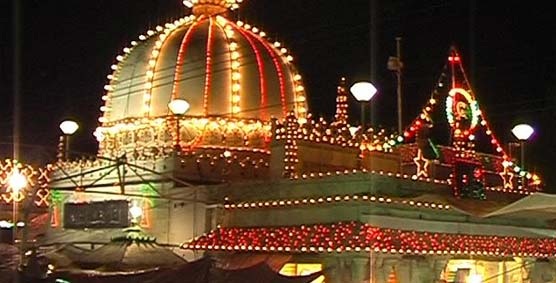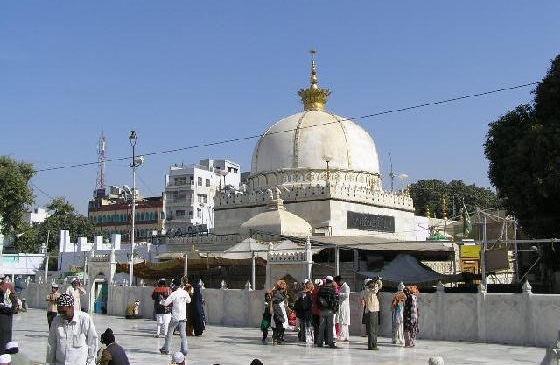
South west of Jaipur, Ajmer is an oasis wrapped in the green hills. The city was founded by Raja Ajay Pal Chauhan in the 7th Century A.D. and continued to be a major centre of the Chauhan power till 1193 A.D.
When Prithviraj Chauhan lost it to Mohammed Ghauri. Since then, Ajmer became home to many dynasties. Today, Ajmer is a popular pilgrimage centre for the Hindus as well as Muslims. Especially famous is the Dargah Sharif-tomb of the Sufi saint Khwaja Moinuddin Chisti, which is equally revered by the Hindus and Muslims.
It is a centre of culture and education, the British chose Ajmer for its prestigious Mayo College a school exclusively for Indian nobility. Ajmer is also the base for visiting Pushkar (11 km.), the abode of Lord Brahma, lying to its west with a temple and a picturesque lake. The Pushkar Lake is a sacred spot for Hindus. During the month of Kartik (Oct./Nov.), devotes throng in large numbers here to take a dip in the sacred lake.
For those who wish to observe a pilgrimage center in India, they should travel to Ajmer Rajasthan. Situated on the way to Pushkar, Ajmer houses the tomb of the 13th century Sufi saint Khwaja Moinuddin Chisti, which is uniformly valued by the Hindus and Muslims. The once a year Urs at the Dargah of Khwaja Moinuddin Chishti is held on a impressive scale and attracts pilgrims from all over the world irrespective of their caste and faith.
A visit to Rajasthan would showcase within its domain a travel tour to Ajmer, situated in Rajasthan, North India, which is standard and comfortable in nature and form. A visit to Rajasthan, coupled with an assistant travel tour to Ajmer, situated in Rajasthan, North India, are two resources of travel information to be collected about Ajmer, Rajasthan, North India. A visit to Ajmer, situated in Rajasthan, North India, is a skillful reminder of the information that Ajmer is a existing example of secularism and passive co existence, with the dargah of Khwaja Moinuddin chisti at Ajmer along with the pilgrimage at Pushkar, and the Brahma temple in the near surrounding area, to be the worshippers point of the both the Hindus and Muslims. Tour to Ajmer, Rajasthan, North India, would showcase a combination of the Mughal and Rajputani style of structural design. Anasagar Lake serves as an ideal picnic and holidaying spot for the tourists and the local population similar.
Shopping in Ajmer Rajasthan is a pleasurable experience. Ajmer is known for antiques, ornaments, charming gold and silver jewelry in modern designs, bandhini (colorful tie-and-dye sarees) and overstated jodhpuri 'Jutis' (shoes). Ittar, a special form of local scent is sold in small and large packs all over Ajmer Rajasthan and is a specialty that one can take home from Ajmer Rajasthan. The yearly Urs Fair is the time one can buy the colorful formations of traditional folk artisans of Ajmer. Colorful clothes and products from Tilonia village and small paintings from Kishangarh and a range of wood crafted products are available throughout the festival. Ajmer is a famous pilgrimage spiritual tourist attraction in the state of Rajasthan. Ajmer provides as the base for most of the long distance journeys to Pushkar, which holds a yearly spiritual festival.
Ajaipal Chauhan founded Ajmer in the seventh century. He constructed a hill fort "Ajaimeur" or the invincible hill. The Chauhans ruled Ajmer till the 12th century when Prithviraj Chauhan lost Mohammed Ghauri. Thereafter it became a part of the sultanate of Delhi. Ajmer was also favourite residence for the great Mughals. One of the first contacts between the Mughal King Jahangir and Sir Thomas Roe took place here in 1616. The Scindias took over the city in 1818 and then handed it over to the British and it became one of the only part of Rajasthan controlled directly by the East Indian Co. The bus stand in Ajmer is located near the RTDC hotel Khadim. And the railway is further north and most of the hotels are west of the stations. Northeast is the main post office and most of the cities market is located behind and up to Agra Gate. Further north is a large artificial lake called the Anna Sagar.
At the foot of a barren hill, is situated India's most important pilgrimage center for people from all faiths. It is the splendid tomb of the Sufi saint Khawaja Moinuddin Chisti more popularly known as Khawaja Saheb or Khawaja Sharif. The shrine is next only to Mecca or Median for the Muslims of South Asia. Emperor Akbar used to make a pilgrimage to this Dargah from Agra once a year. Adhai-Din-Ka Jhonpara - One of the finest examples of Indo-Islamic architecture, this mosque was a Sanskrit college in the 12th century. In 1193 AD Mohammad Ghori destroyed the college and a mosque was built in its place. The mosque is built on pillars and surprisingly no two pillars are alike. The archways are finely engraved with Kufi and Jughra inscriptions from the Holy Quran (also spelt as Koran). Nasiyan (Jain Temple) - This red coloured Jain temple was built in the late 19th century. The wooden gilt in the double storeyed hall depicts scenes from the Jain mythology. The beauty of this temple is widely acclaimed.
Govt. Museum- The Royal palace of Akbar was converted into a museum and today it houses a rich collection of Mughal and Rajput armory. Some of the fine and delicate sculptures of the region have been displayed here. The building itself has been constructed of red sandstone, which have been laid down in a square pattern giving it a fabulous look.
Ana Sagar Lake- This lake was built by Anaji during 1135-1150 AD. Later the Mughal Emperors made additional constructions to beautify the lake. The 'Baradari', a marble pavilion was built by Shah Jahan and the Daulat Bagh Gardens were laid by Jehangir. This lake is located towards the north of Ajmer city. more...
Taragarh Fort- Built in the 7th century by Ajaipal Chauhan, the fort gives a bird's eye view of the city. Taragarh Fort or the 'Star fort' is situated on a hill and to reach there, one has to take winding bridle path.
Mayo College- One of the India's best public schools, located in the south-east of the Ana Sagar, has now been converted to the Circuit House. The lake and the cenotaph and the shrine of the Hindu reformer Swami Dayanand, founder of the "Arya Samaj Movement" in India, can be viewed from here.
Need Aspark Help?
For Tour Packages, Vehicle Rental and Customer Care Support.
+91 9999 31 7846
booking@asparkholidays.comWhy Travel with Us?

Excellent Support
Our Team Available 24x7 for Customer support
Best Price & Savings
We Offer the Most Competitive Prices.


